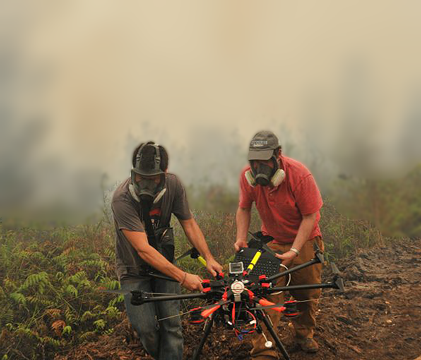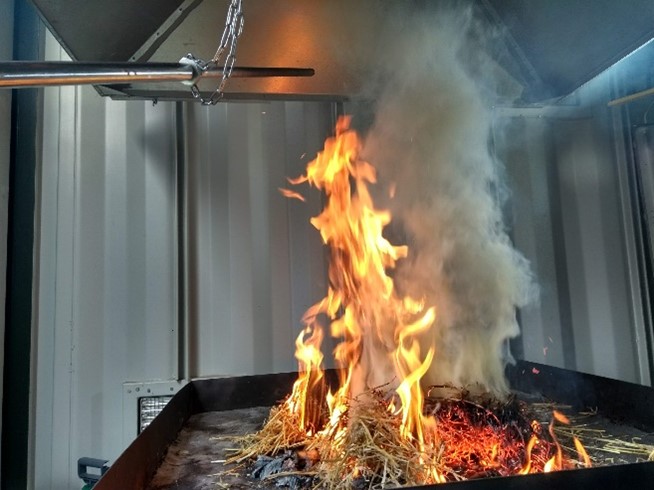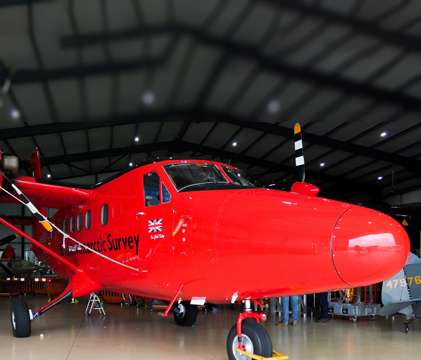
Air quality impacts from fires
Earth observation is vital in air quality modelling and assessments, particularly in regions where substantial and reliable ground networks are unavailable.
Gas and particulate emissions from fires can lead to changes in the composition of the atmosphere. Depending on how this mixing takes place, a range of hazards can be present, mostly at surface level.
Hazards from fire smoke
One of the key hazards from smoke is particulate matter, tiny solid particles, which if inhaled by humans can have serious health impacts. Smaller particles (mostly those of less than 2.5 microns), known as PM2.5 in particular are hazardous as they have the ability to pass from airways into the blood stream. The health impacts can be wide ranging and lead to both short term and long term problems.
One of the key hazards from smoke is particulate matter, tiny solid particles, which if inhaled by humans can have serious health impacts. Smaller particles (mostly those of less than 2.5 microns), known as PM2.5 in particular are hazardous as they have the ability to pass from airways into the blood stream. The health impacts can be wide ranging and lead to both short term and long term problems.

Fire exposure work involving the King’s NCEO team suggests that globally, one in ten deaths of children under the age of five is caused by exposure to fire smoke. Working alongside health practitioners, the team have also found that smoke exposure can result in reduced birthweights in a study in Indonesia.
A key issue with smoke impacting air quality is that it can also affect regions some distance away from the fire sources, as well as having local impacts.
In addition to particulate matter from smoke, gases can also impact air quality when in sufficient concentrations. This can present health impacts in areas with severe smoke pollution when people are exposed to high levels of toxic gases such as CO for long periods of time.
The King’s NCEO team focus on characterising particulate matter emitted from different types of fire, and quantifying concentrations spatially and temporally through in-situ measurements and earth observation.
Measuring air quality using Earth observation
Earth observation is vital in air quality modelling and assessments, particularly in regions where substantial and reliable ground networks are unavailable. The King’s NCEO team have produced algorithms that utilise satellite observations of active fires to estimate emissions of fire-sourced particulate matter.
Fire radiative power (FRP) can be derived from satellite observations of active fires. FRP is a measure of the rate of outgoing thermal energy from a fire and can be correlated to amount of vegetation being burnt. [link]
Algorithms produced by members of King’s-NCEOs staff use these observations of FRP to derive the rate of emissions from a particular fire, employing biome specific emission factors. Emission factors relate the amount of vegetation burnt to the quantity of a species released. These near real-time emission inventories feed into operational products such as the Copernicus Atmospheric Monitoring Service (CAMS) and can provide forecasts of particulate matter during fires as well as running analysis of PM distributions over areas with limited ground equipment.

The King’s team research ‘top-down’ approaches to estimating particulate matter. This technique uses aerosol optical depth, a measure of how much light is absorbed and scattered by airborne particulates, to estimate the mass of particulate matter in a region of the atmosphere. The technique relies on deriving mass extinction coefficients for wildfire smoke, by comparing the known mass of particulates in a smoke plume and the measured aerosol optical depth.
Measuring using instrumentation
For reliable estimates of air quality from earth observation datasets, it is vital that accurate inputs are used, and therefore one key aspect of the NCEO King’s team is in making in-situ measurements for improved validation of EO datasets. Instruments to measure the concentration of particulate matter can be deployed on the ground close to a fire source, or a site impacted by smoke.
Instruments used include filter based samplers which can collect samples for mass correction purposes, and chemical analysis, optical particle counters with a range of concentration limits, or small low-cost sensors which can be deployed as a network [link to SE Asia page]. Some instruments can also be used on manned or unmanned aircraft to directly measure a smoke plume. [Link to Canada Campaign/Airborne Instrumentation]

Recent research
Projects
Lorem ipsum dolor sit amet, consectetur adipiscing elit, sed do eiusmod tempor
Lorem ipsum dolor sit amet, consectetur adipiscing elit, sed do eiusmod tempor
Tools
Lorem ipsum dolor sit amet, consectetur adipiscing elit, sed do eiusmod tempor
.
Contact
For further information contact








